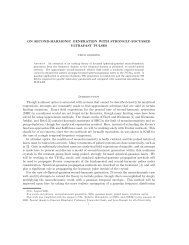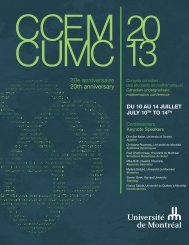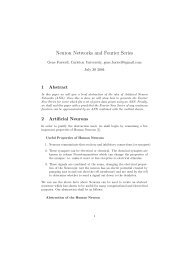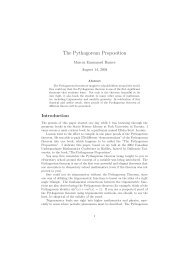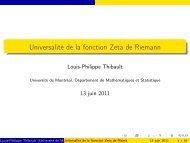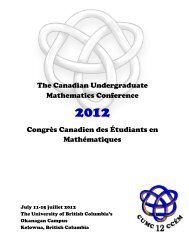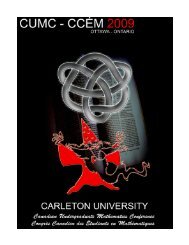booklet - CUMC - Canadian Mathematical Society
booklet - CUMC - Canadian Mathematical Society
booklet - CUMC - Canadian Mathematical Society
You also want an ePaper? Increase the reach of your titles
YUMPU automatically turns print PDFs into web optimized ePapers that Google loves.
mechanics and discuss how the preceding mathematical puzzle serves to prove theincompatibility between locality and quantum theory.Required Background: Linear algebra ; tensor product usefulENUMERATION VIA COMPLEX ANALYSIS: THE LAGRANGE INVERSION FORMULAJOSEPH HORANIn enumeration, as the name would suggest, we like to count things. One methodof doing so is to find coefficients of generating functions; however, this tends to bequite challenging for most problems. One tool used is called (amongst other things)the Lagrange Inversion Formula, which when applied in a clever manner, gives thecoefficients of generating functions satisfying particular implicit equations. Here, webriefly recap some definitions before stating the theorem, showing an example of itspower, and giving a proof via complex analysis, rather than a meaningless algebraicproof. To finish, an outline of a combinatorial proof is given, to show that indeed, thereis meaning involved in the formula, and some history is given to place the formula inthe timeline of mathematics. Experience in enumeration and/or complex analysis isbeneficial but not necessary.MATHEMATICS IN MUSICJULIA TUFTSHave you ever wondered why some musical notes sound better together than others?This talk will explore some of the interesting ways in which mathematics connectswith music.A musical interval is defined to be the difference in pitch between two notes. That is,the difference in how high or low the notes sound. A musical theme is a short melodyoften repeated in a composition. This talk will cover intervals, frequencies, transformationsof themes, and an unexpected way of understanding the pitch spectrum. Noprevious knowledge required, although a familiarity with music will be helpful.LES POLYNÔMES DE TCHEBYCHEVKARINE LAROUCHEJ’expliquerai ce que sont les polynômes de Tchebychev et comment ils peuvent êtreutiles à la résolution de systèmes d’équations différentielles. Je prendrai pour acquisque vous savez ce qu’est une base orthogonale et une courbe paramétrée et que vousêtes un peu familier avec les systèmes d’équations différentielles.THE DYNAMICS OF BIOLOGICAL POPULATIONSKATARZYNA GROTOWSKAThe aim of mathematical ecology is to use techniques from applied mathematicsto model the future populations of biological species. This discussion will provide anoverview of classical and modern mathematical models used to study biological populations.My main goal is to outline the stability of various models by way of equi-33



